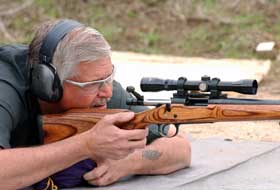Case ReportMoral of this story...keep your blaster away from Big Magnets!
Spontaneous Discharge of a Firearm in an MR Imaging Environment
An incident recently occurred at an outpatient imaging center in western New York State, in which a firearm spontaneously discharged in a 1.5-T MR imaging environment with active shielding. To our knowledge, this is the first documented case of such an occurrence. The event confirms previously reported theoretic risks of a firearm discharging in an MR imaging environment [1]. In this report, we examine the incident in detail from the official police and ballistic reports.
An off-duty police officer went to an outpatient imaging center (not affiliated with our institution) in western New York State to have an MR imaging examination. The facility housed a 1.5-T MR unit (Signa; General Electric Medical Systems, Milwaukee, WI) with active shielding. The officer was carrying a model 1991 A-1 compact.45 caliber semiautomatic pistol (Colt's Manufacturing, Hartford, CT).
The officer notified the technologist that he was carrying the weapon before entering the MR dressing room. The technologist told the officer to take the gun with him. The technologist intended to meet the officer in the MR patient waiting area before the examination and secure the weapon in that room, where he felt it would be safe. However, the officer apparently misunderstood and took the gun into the MR suite. The technologist was entering the officer's personal data into the computer and did not see him entering the MR suite.
Once the officer was inside the MR suite, the gun was pulled from his hand as he attempted to place the gun on top of a cabinet 3 ft (0.9 m) away from the magnet bore. The gun was immediately pulled into the bore, where it struck the left side and spontaneously discharged a round into the wall of the room at the rear of the magnet. Fortunately, no one was injured. Although the gun struck the magnet bore, only minimal cosmetic damage occurred to the magnet itself. The MR unit had full functional capability immediately after the gun discharged. The weapon's thumb safety was reportedly engaged when the gun discharged.
An unsuccessful attempt to remove the gun from the magnet resulted in the gun being pulled to the right side of the magnet (Fig. 1). The decision was then made to power down the magnet to remove the gun.
Thursday, June 28, 2007
An "Accidental" Discharge for the Books!
Stumbled on this on The High Road, from 2001 in the American Journal of Roentgenology (honest):
Subscribe to:
Post Comments (Atom)






10 comments:
moral of the story, put a titanium firing pin in your 1911 (they are not magnetic)
Let's see here; Grip Safety, Safety Lever, Firing-Pin Blocking Safety. To quote a popular firearms handling policy that states: "A Safety is a mechanical device that can and will fail.", I'd like to verify that this isn't an embellished story.
Thanks for the thought food.
I'm not worried... I carry a GLOCK 7. You what that is? That's a ceramic gun that's invisible to x-rays and costs more than you make in a year.
Joemerchant24, you got the quote wrong: (from Die Hard 2)
That punk pulled a Glock 7 on me! You know what that is? It's a porcelain gun made in Germany. It doesn't show up on your airport X-ray machines, and it costs more than you make here in a month!
I work in a hospital, and we just did a little training video on MRI safety. One thing to keep in mind, their magnets are pretty much always on, as they are supercooled, and it takes a while to get them back up to power after shutting them down. Moral of the story - be very careful around MRI machines - the magnet is always on.
Not your typical tactical situation huh? But it definitly is another piece of information that I will file away.
Like most "accidental discharge" stories, something isn't quite right with it. First, the thumb safety blocks the hammer and sear with a steel wedge. If that isn't engaged, and the hammer slips off the sear(?), it's caught by the half-cock notch. Finally, the grip safety prevents the trigger from moving and overriding the half-cock (unless it's depressed). And, the thumb safety reengaged? Really? I'd love to see a forensic exam of the gun.
Oldnarc,
I spotted a thread on this subject. It was fascinating!
I read the whole report and saw the pictures. After discharge, the hammer was back. The fired case was still in the chamber. The manual safety was on. No mention of the firing pin block was made, so I presume it had not been removed from this service weapon. It was investigated by the Rochester NY police department's training officer. I have his name and phone number somewhere around here if you are interested.
It is pretty clear that one of two things happened. The more likely is that the firing pin block was drawn up into its well either by magnetic forces or by inertia at the same instant the muzzle struck the bore of the MRI machine, resulting in a slam fire from the inertial firing pin striking the primer WITHOUT action by the hammer. The less likely scenario was that the primer was ignited by a spark or by heat generated by magnetic eddy currents.
What anonymous said about a titanium firing pin making a difference is incorrect. 1) even non-magnetic (conducting) materials are affected by magnetic fields and 2) magnetic force on the firing pin was not a factor.
We hashed the questions to death on that thread and were left with the unanswered question,. "Was there an indent in the primer?"
It was an amazing set of events.
Larry (Lost Sheep)
Michael, thanks for the blog.
Yes, this really happened Sep 13, 2000.
In my earlier post, I misspoke when I said I had the investiging officer's phone number. All the rest is accurate.
The American Journal of roentgenology is a real publication and this article came out in Volume 178, Issue 5 in May of 2002 describing the analysis of events that occurred in Brighton, New York on September 13, 2000.
I pulled these two partial articles from the web site of the Rochester Democrat and Chronicle.
http://nl.newsbank.com/nl-search/we/Archives?s_site=dem...B%2CE&p_text_date-0=
1. DAILY DIGEST
September 15, 2000 •• 406 words •• ID: roc2000091510092197
Test too risky for magnet-pulled gun It would be too risky to test the gun yanked out of an off-duty city police officer's hand by a heavy-duty magnet this week, a firearms expert said yesterday. The magnet, used for magnetic resonance imaging tests, might have changed the molecular structure of the .45-caliber handgun, said Sgt. William Benwitz, who runs the firearms training unit at the Scottsville Road training academy. "Until we send this gun back to the
2. DAILY DIGEST
September 14, 2000 •• 347 words •• ID: roc2000091410192034
MRI `disarms' police officer Just call it a really magnetic attraction. An off-duty Rochester police officer went to Borg Imaging at 200 White Spruce Blvd., Brighton, yesterday for a magnetic resonance imaging test. The officer asked an office worker about his handgun and, according to Brighton police, was told to keep it with him. But as soon as the officer entered the room holding MRI equipment, the heavy-duty magnet yanked the gun from his hand. Even the bullets
If I wanted more of the articles, I would have had to have broken out my credit card with no promise that a few more paragrpahs would reveal more evidence, so I didn't.
I Googled "William Benwitz" and believe he is still employed by the Rochester PD, so if anyone wanted to call or email to ask if he inspected the back of the primer for firing pin marks... He might respond better to a fellow policeman (if there are any attending this thread) than me, just an idle curiosity seeker.
Larry (Lost Sheep)
It will not work in fact, that is exactly what I think.
Post a Comment